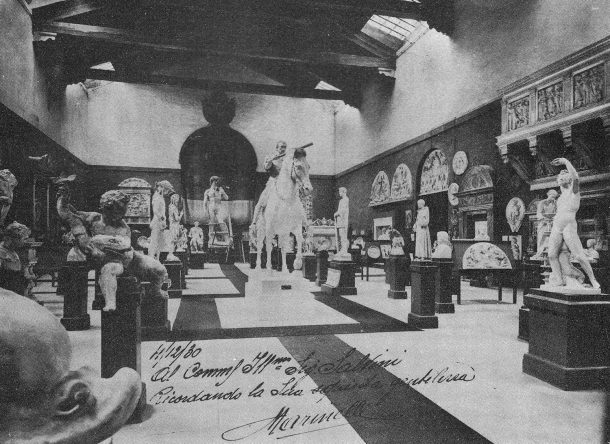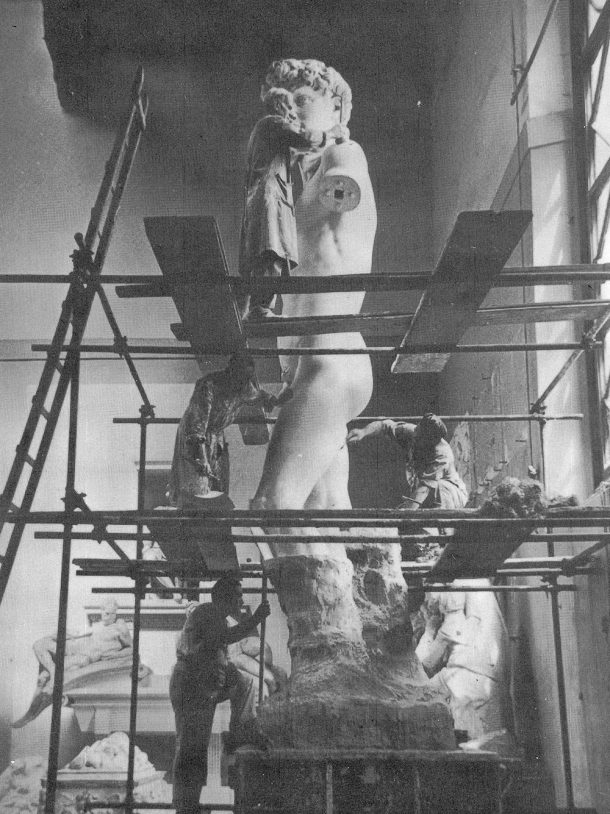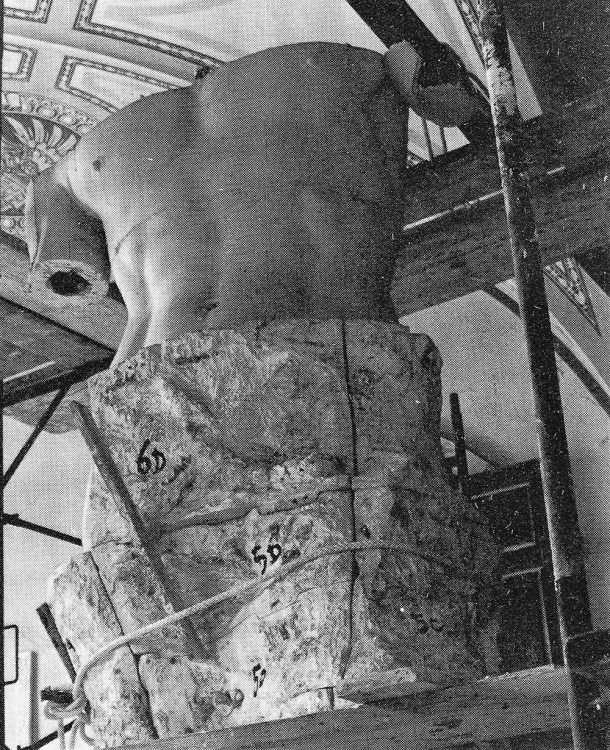I am happy to be writing about the plaster cast of David, having studied it while publishing the Catalogues of Casts in the Istituto Statale d’Arte in the 1980s. Until that point, there had never been any critical historical research on the cast in the riches of the Florentine archives. I’d like to mention several things that may be useful for current discussions.
The plaster copy of David, made by Clemente Papi (1846 – 1847), was transferred in 1929, from the Accademia di Belle Arti in Florence, to the Gipsoteca of the Istituto Statale d’Arte (since 2010 called Liceo Artistico di Porta Romana). The copy was placed in a prime spot at the end of the central aisle of the gallery. You can find more on this in the second volume of the Gipsoteca catalogue of plaster casts, published in 1989. Historical research on the copy was undertaken for the catalogue, when the various Florentine archives were consulted for the first time in relation to the cast. The archives list casts made in the 1900s in the casting workshop, which was added to the Sculpture section of the Istituto Statale d’Arte.
The 19th-century display at the Gipsoteca was modified, and further casts from the Galleria dell’Accademia, of other works by Michelangelo, were displayed near the David, in homage to Michelangelo. It also enabled a dialogue between his work and the piece Alexander subduing Bucephalus, which was located at the entrance. This display evoked both the historic placement of the two plaster copies in the Hall of the Colossus at the Accademia, and the confrontation of the Vasarian tradition with Michelangelo’s superiority over the ancients.

The cast of David became the focal point of the collection, which had already been enriched in 1922 by the acquisition of moulds and casts from the Laboratorio di formatura, or casting workshop, founded by Oronzio Lelli (1821 – 1892).
Lelli put together an important and homogeneous collection, chiefly of medieval and Renaissance originals, thanks to having been one of the trusted formatori (mould makers) at the Royal Florentine Galleries. In the second half of the 19th century, the Royal Florentine Galleries received many requests from major foreign governments for copies that would enrich their plaster cast collections. One example is the copy of the Cantoria (Singing Gallery) by Donatello, requested by the South Kensington Museum in 1876. Although the original once laid disassembled in Florence, it was reconstructed thanks to the study of plaster casts of individual components made by Lelli.
Following the celebrations for the centenary of Michelangelo’s birth, in 1875 the German government was the first to request a complete copy of the statue of David, together with over 70 casts of monumental works. For that, see the documents in the historical archive of the Gallerie fiorentine published in the appendix to the first volume of the Gipsoteca catalogue (1985).
Clemente Papi died in 1875 and thus could not oversee the making of this plaster cast. The work was carried out by his student, Pietro Galli, who often worked with support of the external workshop of Oronzio Lelli. Lelli wrote in his Nota dei getti in gesso (Note on Plaster Casts) dated 1875, that he was already in possession of the head detail of the statue of David. This was probably made from Clemente Papi’s 1847 mould, which had been donated to the Accademia di Belle Arti in Florence. From that first mould, Papi also made a bronze copy, seen on an international stage at the Exposition Universelle in Paris, in 1855. A renewed interest in David was manifest in 1866, when a bronze copy of the entire figure, requested by the The Grand Duke of Tuscany, Leopold II, but not yet installed, was displayed at Champ de Mars in Paris. This was the start of the modern critical acclaim of the statue.
The cast of the head of David soon took on a life of its own, along with other plaster casts of anatomic details of the statue, because these were seen as fundamental for artistic training. A copy of the head appeared in Domenico Brucciani’s Catalogue of Casts in London (c.1860), and also in the 1883 inventory of the teaching collection of plaster casts of the Scuola Professionale delle Arti Decorative ed Industriali (Professional School for Decorative and Industrial Arts) (1869 – 1919) in Florence (later known as the Istituto Statale d’Arte).
In 1929, the Istituto made a replica of the head of David for the Municipio di Rosario di Santa Fè, but was unable to satisfy a request made by the Parisian foundry of Henri Rouard for a whole figure, because the mould parts had been destroyed by the Accademia di Belle Arti. New moulds were made in 1930, following a request from the Municipio di Montevideo. These were the result of several months work by Fonderia Marinelli in Florence, responsible for the copy of the statute of David, and the head detail, and who donated the moulds to the Istituto. The photograph of the David being assembled by Marinelli, in the gallery at the Gipsoteca, belongs to this phase of the works and was a ‘thank you’ to Mario Salvini, then the Director of the institute.

Another complete copy of the David was made from the plaster piece-moulds refurbished by Nello Taccini under the guidance of Giulio Porcinai (1955 – 1956). This was given to the sculptor Giacomo Manzù in 1959, thanks to Colgate University in Hamilton, New York. The copy was placed in the sculptor’s garden, but, as he wrote to me in a letter in 1987, it was destroyed ‘by a crazy gust of wind’.
In 1982, these moulds were used again to cast the statue for the exhibition ‘Made in Florence’, held in the USA. The piece-moulds were put together in four sections (legs to waist, bust, head and arms) and progressively numbered from bottom to top, to simplify the cast-making and transportation processes. The insides of the moulds were coated with soft soap and olive oil to aid the release of the plaster components from the moulds, and small mould pieces for the more minute details were made in wax. The cast sections were then built up vertically. The copy was cast by Gabriele Perugini, Bruni Sodini and Giovanni Hubbard, supervised by Enzo Innocenti.

The Opificio delle Pietre Dure in Florence used the Gipsoteca David to make a cast of the foot as part of the restoration of the marble original which had been damaged in 1991.
There have never been any scientific analyses undertaken on the cast of David. Luigi Lelli (1860 – 1933), son of Oronzio and the last owner of the Lelli workshop, was employed by the Istituto as Master of art at the time of the acquisition of the workshop moulds and casts. He brought with him the 19th-century techniques. These have continued to be passed down orally between master formatori, up to and beyond the introduction of silicone moulds in the 1970s. Currently there remains only the mould of David’s head, half of which is made with plaster pieces, while the other half is in silicone.
Bibliography
A. Caputo Calloud, La dotazione di calchi di opere rinascimentali nell’Accademia di belle arti e il Centenario di Michelangelo (1784-1875); David scheda n. 95; Notizie relative a gessi e formatori tratte dalle filze dell’Archivio dell’Accademia di Belle arti di Firenze, in La scultura italiana dal XV al XX secolo nei calchi della Gipsoteca, a cura di L. Bernardini, A. Caputo Calloud, M. Mastrorocco, Firenze, S.P.E.S, 1989, pp. XVII–XXIX, 148–152, 409–420.
M. Fagioli, G. Perugini, B. Sodini, Tecniche del calco e della formatura in gesso; P. Barocchi, G. Gaeta Bertelà, Appendice documentaria in Donatello e il primo Rinascimento nei calchi della Gipsoteca, a cura di L. Bernardini, A. Caputo Calloud, M. Mastrorocco, Firenze, S.P.E.S, 1985, pp. 247–258; pp. 259- 280 in particolare pp. 265, 268, 273.
Thanks
I am grateful to Johanna Puisto for her kind invitation to contribute to this project, and to Caterina Tiezzi for her translation of my text. I am also grateful for Charlotte Hubbard for editing my text.
Credits
The Archivio storico of the Istituto Statale d’Arte at the Liceo Artistic di Porta Romana, Florence.


